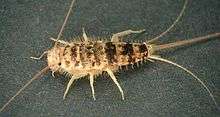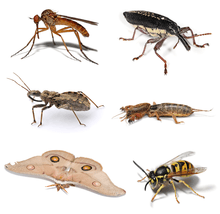Zygentoma
| Zygentoma | |
|---|---|
 | |
| Scientific classification | |
| Kingdom: | Animalia |
| Phylum: | Euarthropoda |
| Class: | Insecta |
| (unranked): | Dicondylia |
| Order: | Zygentoma Börner, 1904 |
| Families | |
Zygentoma are an order in the class insecta. The Zygentoma include the so-called silverfish or fishmoths, and the firebrats. A conspicuous feature of the order is that the members all have three long caudal filaments. The two lateral filaments are cerci, and the medial one is an epiproct or appendix dorsalis. In this they resemble the Archaeognatha, though, unlike in the latter order, the cerci of Zygentoma are nearly as long as the epiproct.[2]
Until the late twentieth century the Zygentoma were regarded as a suborder of the Thysanura,[3] until it was recognized that the order Thysanura was paraphyletic, thus the two suborders were each raised to the status of an independent monophyletic order, with Archaeognatha sister taxon to the Dicondylia, including the Zygentoma.[4][5]

Etymology
The name Zygentoma is derived from the Greek ζυγόν (zygón), in context meaning "yoke" or "bridge"; and ἔντομα (entoma), "insects", literally "cut into" because of the anatomy of typical insects.[6] The idea behind the name was that the taxon formed a notional link between the Pterygota and the Apterygota.[7] This view is now totally obsolete, but the phylogeny of the insecta was in its infancy in the late 19th and early 20th century, and the name was firmly established by the time that more sophisticated views were developed.
Description and ecology
Silverfish are so called because of the silvery glitter of the scales covering the bodies of the most conspicuous species (family Lepismatidae). Their movement has been described as "fish-like" as if they were swimming. Most extant species have a body length less than 2 centimetres (0.79 in) long, though Carboniferous fossils about 6 cm long are known.[5]
Zygentoma have dorsiventrally flattened bodies, generally elongated or oval in outline. Their antennae are slender and mobile. The compound eyes tend to be small and some troglobitic species, such as many Nicoletiidae, lack eyes entirely. Up to three ocelli may be present.[2] The mandibles are short, and the mouthparts unspecialised. Many species also have a number of short appendages on their abdominal segments, but the most distinctive feature of the group is the presence of three long, tail-like filaments extending from their last segment. These three generally subequal, except in some members of the family Nicoletiidae, in which they are short, and the cerci are hard to detect. The two lateral filaments are the abdominal cerci and the medial one is the epiproct.[8]
Silverfish may be found in moist, humid environments or dry conditions, both as free-living organisms or nest-associates. In domestic settings, they feed on cereals, paste, paper, starch in clothes, rayon fabrics and dried meats.[9] In nature, they will feed on organic detritus.[10] Silverfish can sometimes be found in bathtubs or sinks at night, because they have difficulty moving on smooth surfaces and so become trapped if they fall in.
Wild species often are found in dark, moist habitats such as caves or under rocks, and some are commensals living in association with ant colonies, e.g., Trichatelura manni.[11]
There are no current species formally considered to be at conservation risk, though several are troglobites limited to one or a few caves or cave systems, and these species run an exceptionally high risk of extinction.
Families
The Lepismatidae are the largest family and they include the physically largest specimens. The family is cosmopolitan with more than 200 species. Many are anthropophilic, living in human habitations. Some species are inquilines in ant colonies.
The Nicoletiidae are smaller, pale in colour, and live in soil litter, humus, under stones, in caves or as inquilines in ant or termite colonies.
The Ateluridae (sometimes treated as a subfamily Atelurinae within the Nicoletiidae) live in nests of ants and termites and are small and blind.[12]
The Lepidotrichidae are represented by two species: Lepidotrix pilifera from Baltic amber and Tricholepidion gertschi from forests of northern California.
Three species of Maindroniidae are found in the Middle East and in Chile.
Reproduction
Silverfish have an elaborate courtship ritual to ensure exchange of sperm. The male spins a silken thread between the substrate and a vertical object. He deposits a sperm packet (spermatophore) beneath this thread and then coaxes a female to walk under the thread. When her cerci contact the silk thread, she picks up the spermatophore with her genital opening. Sperm are released into her reproductive system, after which she ejects the empty spermatophore and eats it.
Silverfish continue to moult throughout their life, with several sexually mature instars, unlike the pterygote insects. They are relatively slow growing, and lifespans of up to four years have been recorded.[8]
Research for biofuel production
Since silverfish consume lignocellulose found in wood, they are one type of insect (along with termites, wood-feeding roaches, wood wasps, and others) currently being researched for use in the production of biofuel. The guts of these insects act as natural bioreactors in which chemical processes break down cellulose. They have been studied in the hope of developing commercially cost-effective biofuel production processes.[13]
References
- ↑ Howell, H.V., Doyen, J.T. & Purcell, A.H. (1998). Introduction to Insect Biology and Diversity, 2nd ed. Oxford University Press. p. 320. ISBN 0-19-510033-6.
- 1 2 Timothy J. Gibb (27 October 2014). Contemporary Insect Diagnostics: The Art and Science of Practical Entomology. Academic Press. pp. 78–. ISBN 978-0-12-404692-4.
- ↑ Richards, O. W.; Davies, R.G. (1977). Imms' General Textbook of Entomology: Volume 1: Structure, Physiology and Development Volume 2: Classification and Biology. Berlin: Springer. ISBN 0-412-61390-5.
- ↑ A. Blanke, M. Koch, B. Wipfler, F. Wilde, B. Misof (2014) Head morphology of Tricholepidion gertschi indicates monophyletic Zygentoma. Frontiers in Zoology 11:16 doi:10.1186/1742-9994-11-16
- 1 2 P. J. Gullan; P. S. Cranston (13 July 2010). The Insects: An Outline of Entomology. John Wiley & Sons. pp. 202–. ISBN 978-1-4443-1767-1.
- ↑ H. G. Liddell (1889). An Intermediate Greek-English Lexicon: Based on the 7th Ed of Liddell & Scott's Lexicon. page 488
- ↑ Carl Julius Bernhard Börner. Zur Systematik der Hexapoden. Zoologischer Anzeiger vol 27 Pub. 1904 pp 511–533.
- 1 2 Hoell, H.V., Doyen, J.T. & Purcell, A.H. (1998). Introduction to Insect Biology and Diversity, 2nd ed. Oxford University Press. p. 343. ISBN 0-19-510033-6.
- ↑ Silverfish
- ↑
- ↑ Reproductive Morphology and Behavior of a Thysanuran, Trichatelura manni, Associated with Army Ants, R. Torgerson, R. D. Akre 1969. Annals of the Entomological Society of America, 62, pp. 1367–1374
- ↑ Helmut Sturm Zygentoma in Resh VH, Cardé RT. (eds.) (2003) Encyclopaedia of Insects. Academic Press. pp. 1203–1205
- ↑ Sun, Jian-Zhong; Scharf, Michael (June 4, 2010). "Exploring and integrating cellulolytic systems of insects to advance biofuel technology". Insect Science. 17 (3): 163–165. doi:10.1111/j.1744-7917.2010.01348.x.
- Grimaldi, D. and Engel, M.S. (2005). Evolution of the Insects. Cambridge University Press. ISBN 0-521-82149-5.
- Charles A. Triplehorn and Norman F. Johnson, Borror and DeLong's Introduction to the Study of Insects, 7th edition (Thomas Brooks/Cole, 2005), pp. 177–180
- Firefly Encyclopedia of Insects and Spiders, edited by Christopher O'Toole, ISBN 1-55297-612-2, 2002
External links
| Wikimedia Commons has media related to Zygentoma. |
| Wikispecies has information related to Zygentoma |
- Thysanura – Tree of Life Web Project
- Virginia Extension Service Article
